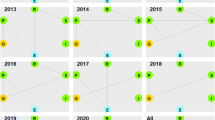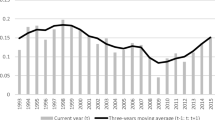Abstract
Gibrat’s law predicts that firm growth is purely random and should be independent of firm size. We use a random effects–random coefficient model to test whether Gibrat’s law holds on average in the studied sample as well as at the individual firm level in the Swedish energy market. No study has yet investigated whether Gibrat’s law holds for individual firms, previous studies having instead estimated whether the law holds on average in the samples studied. The present results support the claim that Gibrat’s law is more likely to be rejected ex ante when an entire firm population is considered, but more likely to be confirmed ex post after market selection has “cleaned” the original population of firms or when the analysis treats more disaggregated data. From a theoretical perspective, the results are consistent with models based on passive and active learning, indicating a steady state in the firm expansion process and that Gibrat’s law is violated in the short term but holds in the long term once firms have reached a steady state. These results indicate that approximately 70 % of firms in the Swedish energy sector are in steady state, with only random fluctuations in size around that level over the 15 studied years.

Similar content being viewed by others
Notes
As the Nordic energy market is expanding, there is still a need for more interconnections between the Nordic countries. How to finance such cross-border investments and how to make transmission systems more efficient are considered by Nylund (2013) in papers 1–3.
The rationale for the classification is discussed in detail in Sect. 4.2.
References
Aitchison J, Brown JAC (1957) The lognormal distribution. Cambridge University Press, Cambridge
Al-Sunaidy A, Green R (2006) Electricity deregulation in OECD (Organization for Economic Cooperation and Development) countries. Energy 31:769–787
Audretsch DB (1995) Innovation, growth and survival. Int J Ind Organ 13:441–457
Audretsch DB, Santarelli E, Vivarelli M (1999) Start-up size and industry dynamics: some evidence from Italian manufacturing. Int J Ind Organ 17:965–983
Audretsch DB, Klomp L, Santarelli E, Thurik AR (2004) Gibrat’s law: are the services different? Rev Ind Organ 24:301–324
Barron DN, West E, Hannan MT (1994) A time to grow and a time to die: growth and mortality of credit unions in New York, 1914–1990. Am J Sociol 100:381–421
Becchetti L, Trovato G (2002) The determinants of growth for small and medium sized firms: the role of the availability of external finance. Small Bus Econ 19:291–306
Bergman L (2005) Why has the Nordic electricity market worked so well? Report no. 05:25. Elforsk, Stockholm, Sweden
Bottazzi G, Secchi A (2005) Growth and diversification patterns of the worldwide pharmaceutical industry. Rev Ind Organ 26:195–216
Calvo JL (2006) Testing Gibrat’s law for young, small and innovative firms. Small Bus Econ 26:117–123
Cefis E, Orsenigo L (2001) The persistence of innovative activities: a cross-countries and cross-sectors comparative analysis. Res Policy 30:1139–1158
Coad A (2009) The growth of firms: a survey of theories and empirical evidence. Edward Elgar, Northampton
Comanor WS, Wilson TA (1967) Advertising, market structure and performance. Rev Econ Stat 49:423–440
Daunfeldt S-O, Elert N, Lang Å (2012) Does Gibrat’s law hold for retailing? Evidence from Sweden. J Retail Consum Serv 19:464–469
Daunfeldt S-O, Elert N (2013) When is Gibrat’s law a law? Small Bus Econ 41:133–147
Daunfeldt S-O, Lang Å, Macuchova Z, Rudholm N (2013) Firm growth in the Swedish retail and wholesale industries. Serv Ind J 33:1193–1205
Delmar F (1997) Measuring growth: methodological considerations and empirical results. In: Donkels R, Miettinen A (eds) Entrepreneurship and SME research: on its way to the next millennium. Ashgate Publishing, Aldershot, pp 199–215
Delmar F, Davidsson P, Gartner W (2003) Arriving at the high-growth firm. J Bus Ventur 18:189–216
Droucopoulos V (1983) International big business revisited: on the size and growth of the world’s largest firms. Manag Decis Econ 4:244–252
Dunne P, Hughes A (1994) Age, size, growth and survival: UK companies in the 1980s. J Ind Econ 42:115–140
Dunne T, Roberts M, Samuelson L (1989) The growth and failure of US manufacturing plants. Q J Econ 104:671–698
Ericson R, Pakes A (1995) Markov-perfect industry dynamics: a framework for empirical work. Rev Econ Stud 62:53–82
Evans DS (1987a) Tests of alternative theories of firm growth. J Polit Econ 95:657–674
Evans DS (1987b) The relationship between firm growth, size and age: estimates for 100 manufacturing industries. J Ind Econ 35:567–581
Fotopoulos G, Giotopoulos I (2010) Gibrat’s law and persistence of growth in Greek manufacturing. Small Bus Econ 35:191–202
Geroski P (1995) What do we know about entry? Int J Ind Organ 13:421–440
Geroski PA, Gugler K (2004) Corporate growth convergence in Europe. Oxford Econ Pap 56:597–620
Gibrat R (1931) Les ine’galite’s e’conomiques. Librairie du Receuil Sirey, Paris
Hall BH (1987) The relationship between firm size and firm growth in the U.S. manufacturing sector. J Ind Econ 35:583–600
Hart PE, Oulton N (1996) The growth and size of firms. Econ J 106:1242–1252
Hardwick P, Adams M (2002) Firm size and growth in the United Kingdom life insurance industry. J Risk Insur 69:577–593
Ijiri Y, Simon H (1974) Interpretations of departures from the Pareto curve firm size distributions. J Polit Econ 82:315–331
Ijiri Y, Simon H (1977) Skew distributions and the sizes of business firms. North-Holland Publishing, New York
Johnson P, Conway C, Kattuman P (1999) Small business growth in the short run. Small Bus Econ 12:103–112
Jovanovic B (1982) Selection and evolution of industry. Econometrica 50:649–670
Kimberley J (1976) Issues in the design of longitudinal organizational research. Sociol Method Res 4:321–347
Lotti F, Santarelli E, Vivarelli M (2003) Does Gibrat’s law hold among young, small firms? J Evol Econ 13:213–235
Lotti F, Santarelli E, Vivarelli M (2009) Defending Gibrat’s law as a long-run regularity. Small Bus Econ 32:31–44
Lucas RE Jr (1978) On the size distribution of business firms. Bell J Econ 9:508–523
Lundgren J (2012) Market liberalization and market integration: essays on the Nordic electricity market. Umeå Econ Stud no 852
Mansfield E (1962) Entry, Gibrat’s Law, innovation, and the growth of firms. Am Econ Rev 52:1023–1051
Mowery DC (1983) Industrial research and firm size, survival, and growth in American manufacturing, 1921–1946: an assessment. J Econ Hist 43:953–980
Nylund H (2013) Electricity across borders: regional cost sharing of grid investments, international benchmarking and the electricity demand of an ageing population. Dissertation, Luleå University of Technology
Penrose ET (1959) The theory of the growth of the firm, 3rd edn. Oxford University Press, Oxford
Rabe-Hesketh S, Skrondal A (2005) Multilevel and longitudinal modeling using Stata. Stata Press, College Station
Reid GC, Xu Z (2012) Generalising Gibrat: using Chinese evidence founded on fieldwork. Small Bus Econ 39:1017–1028
Simon HA, Bonini CP (1958) The size distribution of business firms. Am Econ Rev 58:607–617
Stam E (2010) Growth beyond Gibrat: firm growth processes and strategies. Small Bus Econ 35:129–135
Steindl J (1965) Random processes and the growth of firms: a study of the Pareto law. Griffin, London
Sutton J (1991) Sunk costs and market structure: price competition, advertising, and the evolution of concentration. MIT Press, Cambridge
Teruel-Carrizosa M (2010) Gibrat’s law and the learning process and strategies. Small Bus Econ 34:355–373
Variyam JN, Kraybill D (1992) Empirical evidence on determinants of firm growth. Econ Lett 38:31–36
Viner J (1932) Cost curves and supply curves. Zeitschrift für Nationalöconomie 3:23–46
Vivarelli M (2013) Is entrepreneurship necessarily good? Microeconomic evidence from developed and developing countries. Ind Corp Change 22:1453–1459
Wagner J (1992) Firm size, firm growth, and persistence of chance: testing Gibrat’s law with establishment data from Lower Saxony, 1978–1989. Small Bus Econ 4:125–131
Wagner J (1994) Small firm entry in manufacturing industries: Lower Saxony, 1979–1989. Small Bus Econ 6:211–224
Weiss C (1998) Size, growth, and survival in the upper Austrian farm sector. Small Bus Econ 10:305–312
Acknowledgments
I would like to express my thanks to Professor Niklas Rudholm for his valuable and constructive suggestions during this research work. His willingness to give his time so generously was very much appreciated. My gratitude is also extended to Professor Lars Hultkranz and Ph.D. student Zuzana Machucova for their useful comments on this paper. Finally, I wish to thank the audience at a seminar in May 2013 at Örebro University for their valuable comments and suggestions.
Author information
Authors and Affiliations
Corresponding author
Rights and permissions
About this article
Cite this article
Tang, A. Does Gibrat’s law hold for Swedish energy firms?. Empir Econ 49, 659–674 (2015). https://doi.org/10.1007/s00181-014-0883-x
Received:
Accepted:
Published:
Issue Date:
DOI: https://doi.org/10.1007/s00181-014-0883-x




